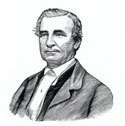John Hunn (farmer) facts for kids
Quick facts for kids
John Hunn
|
|
|---|---|
 |
|
| Personal details | |
| Born | June 25, 1818 Kent County, Delaware |
| Died | July 6, 1894 (aged 76) Camden, Delaware |
| Spouse | Mary Jenkins Swallow |
| Residence | Camden, Delaware |
John Hunn (born June 25, 1818 – died July 6, 1894) was an American farmer and a brave abolitionist. An abolitionist was someone who worked to end slavery. John Hunn was a "station master" for the Underground Railroad in Delaware. This was the most southern "station" on the Delmarva Peninsula, helping enslaved people escape to freedom.
Contents
John Hunn's Early Life
John Hunn was born on June 25, 1818, on a farm called Wildcat Manor in Kent County, Delaware. His parents, Ezekiel and Hannah Hunn, were both Quakers and believed strongly in ending slavery. Sadly, John became an orphan when he was very young, as both his parents passed away. He and his brothers and sisters were raised by relatives. Later, his sister encouraged him to become a minister.
John Hunn married Mary Swallow. At first, she was not a Quaker, which caused a small issue with his local Quaker meeting. However, Mary soon joined the Quaker faith, and they were able to continue their membership at another meeting near their farm, "Happy Valley," close to Middletown, Delaware. They had several children, including John, who later became the Governor of Delaware. After Mary passed away, John Hunn married Anne Jenkins.
Helping People Escape Slavery
John Hunn played a very important role in the Underground Railroad. This was a secret network of safe houses and routes that helped thousands of enslaved people escape to freedom. John Hunn worked with other brave people like John Alston, Daniel Corbit, and Thomas Garrett. They helped people travel through Delaware, up the Delmarva Peninsula, to Wilmington, Delaware, and then into Pennsylvania, where they could be free.
A Brave Act of Kindness
In December 1845, John Hunn helped a freedman named Samuel Hawkins and his family of seven escape from slavery in Maryland. Even though slave catchers found the family on Hunn's farm, a local sheriff noticed a problem with their legal papers. In early 1846, a Delaware judge named James Booth Jr. set the family free. Another abolitionist, James Wales, helped with the legal side, and Thomas Garrett quickly arranged for a coach to take them across the border into Pennsylvania.
Facing Consequences for Freedom
The slave owners were very upset. They sued John Hunn and Thomas Garrett for breaking the Fugitive Slave Act. This law made it illegal to help enslaved people escape. The trial took place in the U.S. District Court and was overseen by important judges, including U.S. Supreme Court Chief Justice Roger B. Taney.
Both Hunn and Garrett were found guilty and had to pay very large fines. The prosecutor, James Bayard, reportedly told Hunn that he wouldn't have to pay the fines if he promised to stop helping enslaved people. But John Hunn bravely said he would "never withhold a helping hand from the down-trodden in their hour of distress." Because he refused to stop, all his land and belongings were sold to pay the fines in 1848. This left his family with nothing, but John Hunn still continued his fight against slavery.
Life After the Civil War
After losing his farm, John Hunn lived with relatives for a while. During the American Civil War, John Hunn could not fight in the military because of his Quaker beliefs, which promote peace. After the war ended, he and his family moved to the Sea Islands in South Carolina. There, he worked with the Freedmen's Bureau, an organization that helped newly freed enslaved people. He also worked as a customs officer in Beaufort, South Carolina.
John Hunn's Legacy
John Hunn passed away on July 6, 1894, in Camden, Delaware. He was living with his son, John Hunn Jr., who had moved back to Delaware and later became the state's governor. John Hunn was buried at the Camden Friends Meetinghouse.
John Hunn was a very humble person. To protect others from possible trouble, he asked his son to burn his personal papers when he died. However, some of his actions were recorded by others, like William Still in Philadelphia, who wrote about some of Hunn's work.
Today, the original Hunn family home, Wildcat Manor, is part of a nature park called "Hunn Park." A special part of the federal Underground Railroad historic trail in Delaware visits places connected to John Hunn and his father. Delaware has also put up a historical marker in Camden near his grave to honor his important work.

